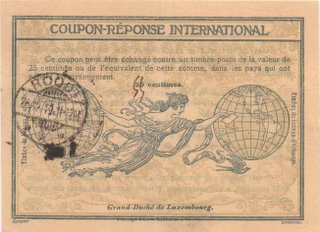
 Here’s a card sent by a postal clerk in Wiltz (“Commis des postes à Wiltz”) to any “Employé des Postes à Maracaybo,” Venezuela in 1888. I hope somewhere in cyberspace there is a philatelist who can explain the apparent route that the ten-centime 1885 Allegory postal card [Prifix 48a] took in reaching its destination after a 33-day, five-country odyssey. Here’s the route that the cancels disclose:
Here’s a card sent by a postal clerk in Wiltz (“Commis des postes à Wiltz”) to any “Employé des Postes à Maracaybo,” Venezuela in 1888. I hope somewhere in cyberspace there is a philatelist who can explain the apparent route that the ten-centime 1885 Allegory postal card [Prifix 48a] took in reaching its destination after a 33-day, five-country odyssey. Here’s the route that the cancels disclose:- Wiltz, in Luxembourg’s Ardenne, April 10, 1888
- London, England, April 11, 1888 [red cancel]
- Nancy, France, April 12, 1888
- Curaçao, Dutch West Indies (!), May 13, 1888 [back]
Traveling to London and then back to Nancy in the French Lorraine seems bizarre. The stop at Curaçao, the Dutch island off the coast of Venezuela, seems reasonable, although the Curaçao cancel is a surprise. Perhaps the card was transferred from a ship coming into the port at Willemstad to another ship going on to Maracaibo, on the extreme northwest coast of Venezuela.













